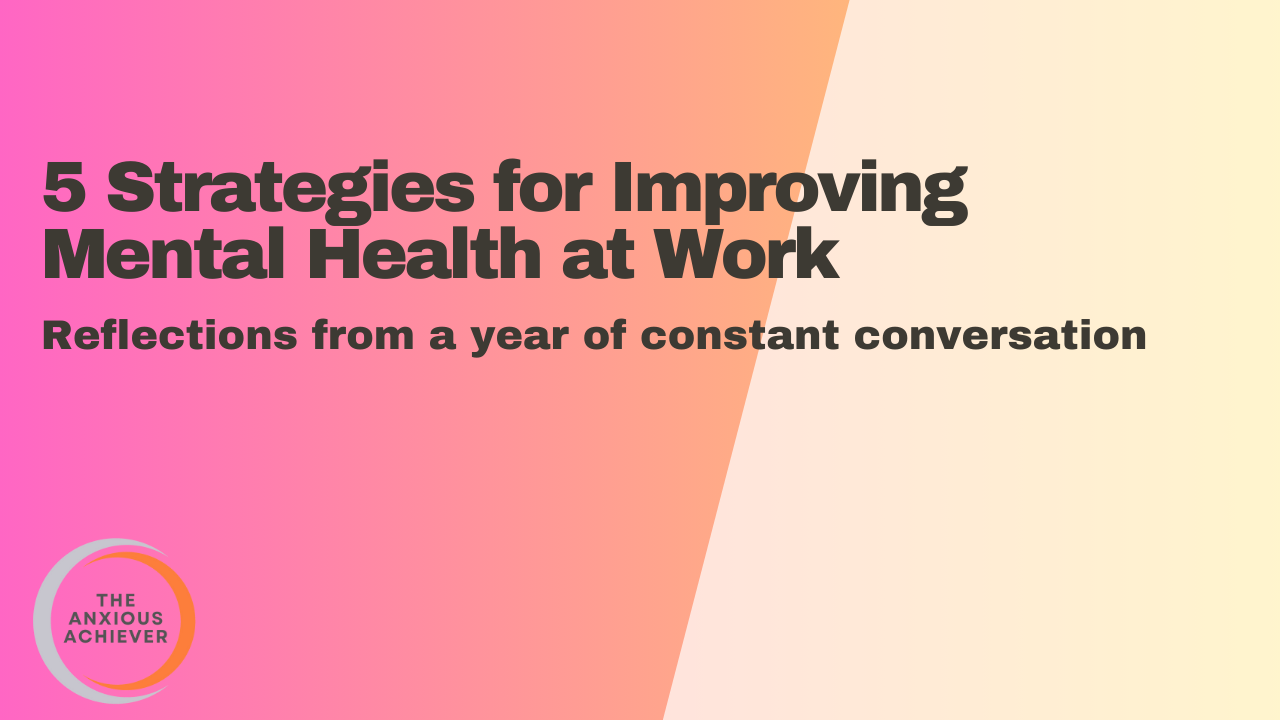HBR: My 5 Strategies For Better Mental Health At Work
It's been a year since The Anxious Achiever was published, and the feedback I've received has been both heartening and infuriating. So many of you have shared stories of how work stress has taken a toll on your physical and mental well-being, and it's clear that workplace cultures haven't caught up with the conversations around mental health.
Those of us in the workplace mental health field look forward to the day when we don’t have to try so hard to convince organizations to invest in this work.
My most recent HBR piece offers my strategies for tackling mental health at work- what I call the urgent agenda. You can read more in the Harvard Business Review.
1. Start with the work: Improving workplace mental health involves tackling how, why, and where we work. Pat advice on putting your phone away in the evening or scheduling your emails feels so 2020.
Get specific and focus on the work product you need and how you can better support the employees involved. Advice from flexible workplace expert Cali Williams Yost should be the cornerstone of any well-being initiative: When you start with what needs to get done, Yost says, teams can “reimagine how, when, and where work is done to perform effectively as an organization, and help people be their best as well.” Consider new research from JAMA, which finds that greater job flexibility is associated with decreased odds of serious psychological distress and lower odds of weekly anxiety. Blanket policies rarely succeed; instead, tailor solutions to the specific stressors of your organization.
2. Engage internal champions: Don't rely solely on outside experts or HR. Recruit well-respected insiders who are willing to model healthy practices and take some risks. As Newton Cheng says, "It gets really hard to do anything about mental health until you see someone who's doing it right in front of you.”
3. Foster conversations across generations and genders:
To me, gender and generation are two elephants in the room that need to be addressed! Every generation at work struggles with their mental health; it’s not just young people who want to talk about their feelings. And, men want to share their emotions at work but might feel more stigma than women. How can workplaces tackle these biases?
Read more in HBR.
4. Invest in what matters: Recognize that technology won't fix our mental health issues; it's part of the problem. Focus on building relationships and helping people feel heard and seen.
5. Walk the talk: No matter your level in the company, be persistent in advocating for mental health. Mental health is core to everything we do at work. Protecting it will take all of us.
Psychologist Emily Anhalt notes that the reason why there are more mental health benefits now is that enough people said, “I'm not going to work here if that's not part of it.”
Leaders also need to “do the work” of getting in touch with how their own emotions color their work lives. And they carry immense power to destigmatize mental health conversations by sharing what they are doing to preserve their mental health and how those actions are impacting them.
Magic in service of workplace mental health can happen at all levels of an organization and some of the simplest, human-centered tactics can be incredibly powerful. Have a candid conversation with a coworker. Find strength in numbers by asking for policy change with colleagues. Be the team leader who reaches out to encourage a more reasonable sign-off time after seeing midnight email timestamps from your staff. Be the CEO or VP who shares a personal story so others who struggle can feel seen.
We all have issues to work through because we’re human. But we can thrive at work when our needs get the air time and support they need and deserve.
Take care,
Morra
P.S.: Have you read The Anxious Achiever yet?


